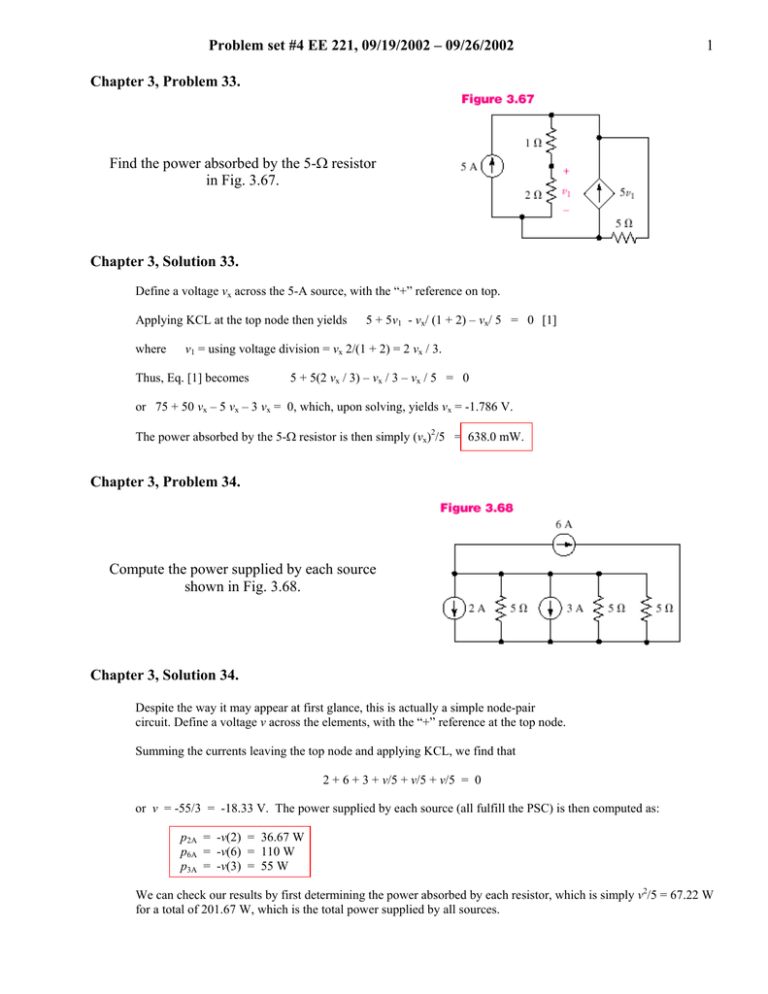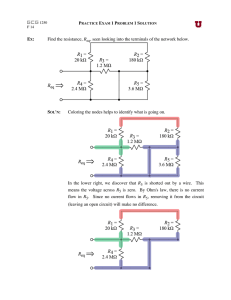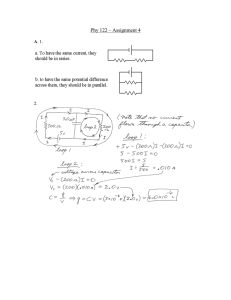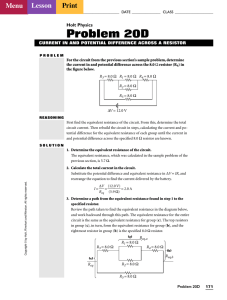Problem set #4 EE 221, 09/19/2002 – 09/26/2002 1 Chapter 3
advertisement

Problem set #4 EE 221, 09/19/2002 – 09/26/2002 1 Chapter 3, Problem 33. Find the power absorbed by the 5-Ω resistor in Fig. 3.67. Chapter 3, Solution 33. Define a voltage vx across the 5-A source, with the “+” reference on top. Applying KCL at the top node then yields where 5 + 5v1 - vx/ (1 + 2) – vx/ 5 = 0 [1] v1 = using voltage division = vx 2/(1 + 2) = 2 vx / 3. Thus, Eq. [1] becomes 5 + 5(2 vx / 3) – vx / 3 – vx / 5 = 0 or 75 + 50 vx – 5 vx – 3 vx = 0, which, upon solving, yields vx = -1.786 V. The power absorbed by the 5-Ω resistor is then simply (vx)2/5 = 638.0 mW. Chapter 3, Problem 34. Compute the power supplied by each source shown in Fig. 3.68. Chapter 3, Solution 34. Despite the way it may appear at first glance, this is actually a simple node-pair circuit. Define a voltage v across the elements, with the “+” reference at the top node. Summing the currents leaving the top node and applying KCL, we find that 2 + 6 + 3 + v/5 + v/5 + v/5 = 0 or v = -55/3 = -18.33 V. The power supplied by each source (all fulfill the PSC) is then computed as: p2A = -v(2) = 36.67 W p6A = -v(6) = 110 W p3A = -v(3) = 55 W We can check our results by first determining the power absorbed by each resistor, which is simply v2/5 = 67.22 W for a total of 201.67 W, which is the total power supplied by all sources. Problem set #4 EE 221, 09/19/2002 – 09/26/2002 Chapter 3, Problem 50. Find Req for each of the resistive networks shown in Fig. 3.82. 2 3 Problem set #4 EE 221, 09/19/2002 – 09/26/2002 Chapter 3, Solution 50. (a) Working from right to left, we first see that we may combine several resistors as 100 Ω + 100 Ω || 100 Ω + 100 Ω = 250 Ω, yielding the following circuit: 100 Ω Req → 100 Ω 100 Ω 100 Ω 100 Ω 100 Ω 250 Ω 100 Ω Next, we see 100 Ω + 100 Ω || 250 Ω + 100 Ω = 271.4 Ω, and subsequently 100 Ω + 100 Ω || 271.4 Ω + 100 Ω = 273.1 Ω, and, finally, Req = 100 Ω || 273.1 Ω = 73.20 Ω. (b) First, we combine 24 Ω || (50 Ω + 40 Ω) || 60 Ω = 14.4 Ω, which leaves us with 5Ω 10 Ω Req → 14.4 Ω 20 Ω Thus, Req = 10 Ω + 20 Ω || (5 + 14.4 Ω) = 19.85 Ω. (c) First combine the 10-Ω and 40-Ω resistors and redraw the circuit: 15 Ω 10 Ω 2Ω 50 Ω 8Ω 20 Ω 30 Ω We now see we have (10 Ω + 15 Ω) || 50 Ω = 16.67 Ω. Redrawing once again, 16.67 Ω 2Ω 8Ω 50 Ω where the equivalent resistance is seen to be 2 Ω + 50 Ω || 16.67 Ω + 8 Ω = 22.5 Ω. Problem set #4 EE 221, 09/19/2002 – 09/26/2002 Chapter 3, Problem 51. In the network shown in Fig. 3.83: (a) let R = 80 Ω and find Req; (b) find R if Req = 80 Ω; (c) find R if R =Req. Chapter 3, Solution 51. (a) Req = [(40 Ω + 20 Ω) || 30 Ω + 80 Ω] || 100 Ω + 10 Ω = 60 Ω. (b) Req = 80 Ω = [(40 Ω + 20 Ω) || 30 Ω + R] || 100 Ω + 10 Ω 70 Ω = [(60 Ω || 30 Ω) + R] || 100 Ω 1/70 = 1/(20 + R) + 0.01 20+ R = 233.3 Ω therefore R = 213.3 Ω. (c) R = [(40 Ω + 20 Ω) || 30 Ω + R] || 100 Ω + 10 Ω R – 10 Ω = [20 + R] || 100 1/(R – 10) = 1/(R + 20) + 1/ 100 3000 = R2 + 10R – 200 Solving, we find R = -61.79 Ω or R = 51.79 Ω. Clearly, the first is not a physical solution, so R = 51.79 Ω. Chapter 3, Problem 61. For the circuit in Fig. 3.91, determine ix, and compute the power dissipated by (absorbed by) the 15-kΩ resistor. Chapter 3, Solution 61. Replace the top 10 kΩ, 4 kΩ and 47 kΩ resistors with 10 kΩ + 4 kΩ || 47 kΩ = 13.69 kΩ. Define vx across the 10 kΩ resistor with its “+” reference at the top node: then vx = 5 · (10 kΩ || 13.69 kΩ) / (15 kΩ + 10 || 13.69 kΩ) = 1.391 V ix = vx/ 10 mA = 139.1 µA v15 = 5 – 1.391 = 3.609 V and p15 = (v15)2/ 15×103 = 868.3 µW. 4 Problem set #4 EE 221, 09/19/2002 – 09/26/2002 Chapter 3, Problem 62. For the circuit in Fig. 3.92, find ix, iy, and the power dissipated by (absorbed by) the 3-Ω resistor. Chapter 3, Solution 62. We may combine the 12-A and 5-A current sources into a single 7-A current source with its arrow oriented upwards. The left three resistors may be replaced by a 3 + 6 || 13 = 7.105 Ω resistor, and the right three resistors may be replaced by a 7 + 20 || 4 = 10.33 Ω resistor. By current division, iy = 7 (7.105)/(7.105 + 10.33) = 2.853 A We must now return to the original circuit. The current into the 6 Ω, 13 Ω parallel combination is 7 – iy = 4.147 A. By current division, ix = 4.147 13/ (13 + 6) = 2.837 A and px = (4.147)2 · 3 = 51.59 W 5








